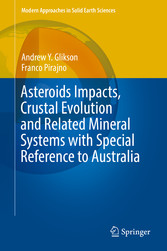Suche
Lesesoftware
Info / Kontakt
Asteroids Impacts, Crustal Evolution and Related Mineral Systems with Special Reference to Australia
von: Andrew Y. Glikson, Franco Pirajno
Springer-Verlag, 2018
ISBN: 9783319745459 , 215 Seiten
Format: PDF
Kopierschutz: Wasserzeichen



Preis: 139,09 EUR
eBook anfordern 
Mehr zum Inhalt

Asteroids Impacts, Crustal Evolution and Related Mineral Systems with Special Reference to Australia
This book presents a comprehensive overview of Australian impact structures and related mineralization, including a discussion of the significance of many of these structures for crustal evolution. The book focuses in particular on Archaean impact ejecta/fallout units in the Pilbara Craton of Western Australia, large exposed and buried impact structures, and on the geophysical evidence for possible to probable impact structures. Thanks to their long-term geological stability, Precambrian and younger terrains in the Australian continent contain 38 confirmed impact structures and 43 ring and dome structures, many of which constitute possible to probable asteroid impact structures. The impact structures have been the subject of more than half a century of studies and range from several tens of meter-large craters to buried structures larger than 100 km in diameter. Discoveries of impact fallout units in the Pilbara Craton have defined the Pilbara as one of the two best documented terrains where Archaean impact ejecta/fallout deposits are identified, the other terrain being the Kaapvaal Craton in southern Africa. A synthesis of evidence from both cratons indicates periods of large asteroid bombardments during -3.47 - 2.48 billion years-ago, including peak bombardment about 3.25-3.22 billion years-ago. The latter period coincides with an abrupt transformation of an early Archaean granite-greenstone crust to mid to late Archaean semi-continental crustal regimes, underpinning the significance of heavy asteroid impact events for crustal evolution. Apart from proven impact structures, Australian terrains display a range of circular features, including morphological and drainage rings, circular lakes, volcanic craters, tectonic domes, oval granite bodies, mafic igneous plugs, salt diapirs, and magnetic, gravity and seismic anomalies, many of which are of a likely impact origin. Thermal and hydrothermal processes associated with impact cratering bear important consequences for the formation of mineral deposits, such as Ni at Sudbury, Pb-Zn at Siljan and Kentland. Impact structures may also provide sites for the accumulation of hydrocarbons, whereas in some instances fracturing associated with impact structures allows outward migration of oil and gas.
Andrew Y. Glikson, an Earth and paleo-climate scientist, studied geology at the University of Jerusalem and graduated at the University of Western Australia in 1968. He conducted geological surveys of the oldest geological formations in Australia, South Africa, India and Canada; studied large asteroid impacts, including effects on the atmosphere and oceans of mass extinction of species. Since 2005 he studied the relations between climate and human evolution. He was active in communicating nuclear issues and climate change evidence to the public and parliament through papers, lectures, conferences and presentations.Andrew Glikson has published already several earlier book volumes with Springer, among which 'The Asteroid Impact Connection of Planetary Evolution' in 2013, 'Climate, Fire and Human Evolution: The Deep Time Dimensions of the Anthropocene', (with C. Groves), in 2016 and 'The Plutocene: Blueprints for a Post-Anthropocene Greenhouse Earth' in 2017.
Franco Pirajno is a recognized expert on mineral systems, with more than 50 years of experience, in industry, academia and government. He has extensive knowledge of tectonics, ore deposit geology in: Europe, southern Africa, South East Asia, New Zealand, southwest Pacific, China, southern Siberia, Greenland and Australia. He is the author of four books and a monograph on mineral deposits and of more than 175 peer-reviewed papers, 20 peer-reviewed geological maps and 68 unpublished company reports.
Franco Pirajno is a recognized expert on mineral systems, with more than 50 years of experience, in industry, academia and government. He has extensive knowledge of tectonics, ore deposit geology in: Europe, southern Africa, South East Asia, New Zealand, southwest Pacific, China, southern Siberia, Greenland and Australia. He is the author of four books and a monograph on mineral deposits and of more than 175 peer-reviewed papers, 20 peer-reviewed geological maps and 68 unpublished company reports.




